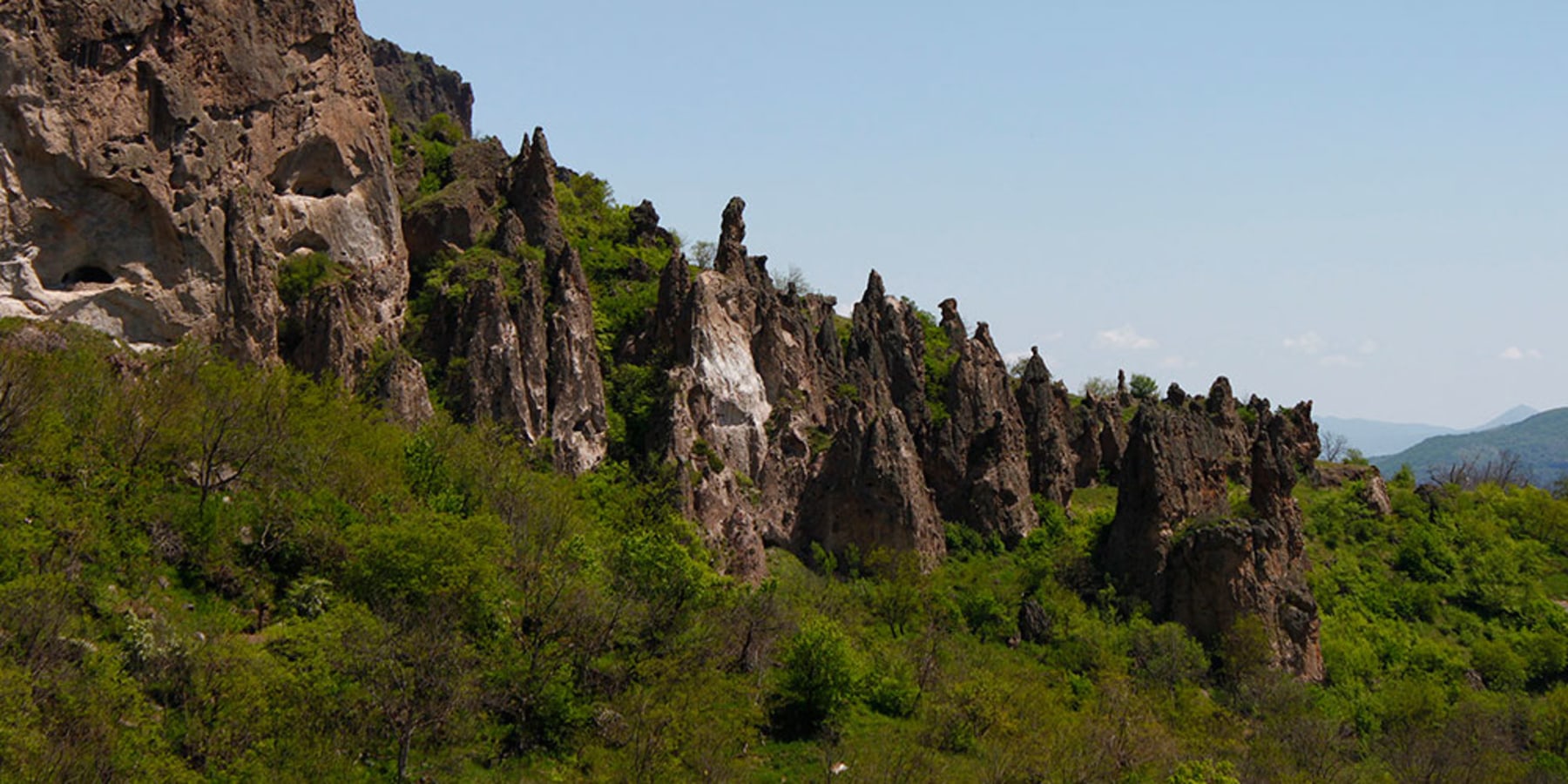
Rich in breathtaking natural, historical, and cultural landscapes, Armenia offers countless fascinating attractions to the curious and adventurous traveler. With many mountains, rivers, and lush forests to enjoy along with remote regions, forts, and monasteries to discover, the country will never cease to impress. We explore the ten most beautiful landscapes in Armenia that are must-visits.
Tatev Monastery
Church, Monastery, Natural Feature:
Located on an 850-meter-high (2,790 ft.) cliff above springs and incredible nature, the 9th-century monastery of Tatev is a must-visit not only for its religious and historical importance but also for its breathtaking natural landscapes all around. To reach it, travellers can hop on board the cableway between Halidzor and the monastery and enjoy the stunning views from above. In medieval Armenia, this was the location of the country’s most important scholastic and spiritual center. Today, this old and famous complex is certainly one of Armenia’s most impressive sites of interest.
Tatev Monastery Complex:
Tatev Monastery is a 9th century historical monument. It is one of the oldest and most famous monastery complexes in Armenia. During medieval times Tatev Monastery was a vital scholastic, enlightenment and spiritual center and played a singular role in the country’s history.
Restoration of the monastery, re-establishing its educational legacy and reviving monastic life at Tatev is one of the main goals of Tatev Revival Program, a part of which is Wings of Tatev aerial tramway.
What you will see:
Mighty fortress walls upon massive cliffs;
An ancient oil mill with stone grinders;
Pendulous Column – a unique medieval structure
Ancient frescoes by European masters.
Devil’s Bridge (Satani Kamurdj)
Located below Tatev Monastery, in the 500-meter gorge of the Vorotan River, is one of Armenia’s natural wonders – “Devil’s Bridge”. Over the millennia, wind and water have created this wonder of nature, polishing and piercing the petrified lava. The width of this natural bridge, along which runs the auto road to Tatev Monastery, is 60 m, the length 30 m. Close to the bridge, it is possible to swim in the warm salubrious springs, ringed by stalactites of marvellous colours. The most intrepid can descend to the river to see the secretive grottos below the springs.
Harsnadzor Watchtower
The watchtower point remains directly above the gorge – the third in a chain of warnings developed in the Zangezur Mountains in case of enemy attack. Seeing a foe, the guards in Kordzor struck an alarm, the bell in Khot relayed the news, and then the watchpoint in Harsnadzor and, finally, the big bell at Tatev Monastery, whose ring was heard across a 50 km radius. Enemies severed the chain of notification when they burned the bell in Khot. Today, remaining in the Harsnadzor watchpoint is the rotunda with the chains that once supported the bell.
Great Hermitage of Tatev (Tatevi Mets Anapat)
Preserved on the right bank of Vorotan River are the ruins of the shelter of the Kharants hermits (Great Hermitage of Syunik).
It was founded by monks in 1608–1613. The terrible earthquake of 1658 forced the hermits to leave the community and build a new one several kilometres from Kharants – monastery complex the Great Hermitage of Tatev. The Hermitage of Tatev is visible from the cabin windows on the third, longest section of Wings of Tatev cableway. A steep switchback road descends to the Hermitage from Tatev Monastery.
Mountain Villages And Churches
Standing motionless on the bottom and slopes of the picturesque Vorotan Gorge are the villages abandoned in the middle of the last century.
Old Khot Village:
Remaining in Khot is the church Mrgadzori Khach (“Cross of the fruit ravine”), which, according to local lore, was built by a famous beauty having fled the harem of Shah Abbas of Persia.
Yeritsatumb Village:
Famous for St. Minas Church (1821), waterfall and basin, which was filled with miraculous water that cured children of various illnesses, and women from infertility. In the summer, the church is thickly shrouded in vegetation, its roof and walls are covered with bright blue forget-me-nots.
Old Halidzor:
In the early 10th century, the village of Halidzor was gifted to Tatev. The village belonged to the monastery until the 19th century. The small stone homes of this yet another abandoned village were built with a cascade, traditional for Armenian alpine villages, where the roof of the lower home serves as the floor and courtyard of the upper one.
Old Shinuhayr Village:
The village’s exact age is unknown. The 10th century is mentioned in the written documents studied to date, however, the very name of the villa, Shinuhayr (“Father of settlements”), evidences that it was among the oldest in Syunik. Evidence exists that a strong earthquake in the 13th century destroyed the village’s central church, built on the site of the former, which was constructed in the 4-5th centuries. The church was rebuilt after the earthquake and remains standing in Old Shinuhayr, in the Vorotan Ravine. Located here as well is a cemetery with numerous ancient gravestones, among which stands out a three-meter-tall cross-stone (1261).
Vorotan Gorge:
Flowing deep in the gorge, above which passes the Wings of Tatev cableway, is the Vorotan River. Nestled in the picturesque canyon are salubrious water springs, ancient cave dwellings and the shelters of hermits.

